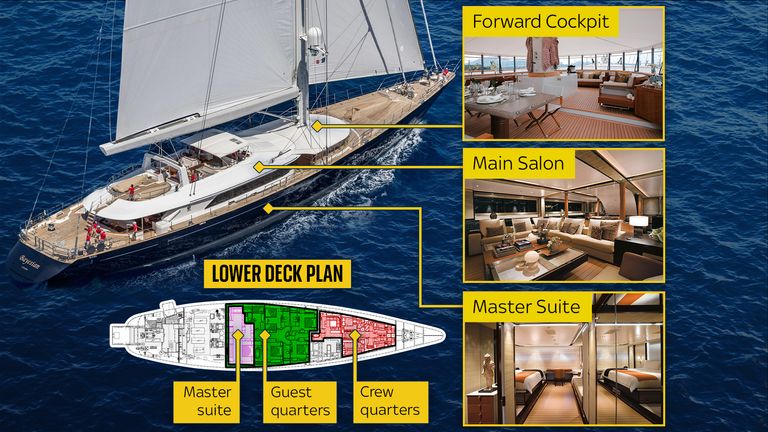The search operation to find those missing after the sinking of the Bayesian superyacht has been plagued with difficulties.
Six bodies have been found after the luxury vessel went down off the coast of Sicily in the early hours of Monday, with one person still unaccounted for.
Here, Sky News looks at the factors that have made the search and rescue operation so difficult.
Follow latest updates on superyacht sinking
Depth of the wreckage
Marco Tilotta, a diver who has been coordinating the search and rescue, said teams have been working continuously since Monday but conditions below the water have been “prohibitive”.
The British-flagged superyacht is still largely intact on the seabed, but the 50m depth to which it sank makes it difficult to access.
The depth is far deeper than most recreational divers are qualified to reach and requires special precautions.
This mean divers can only spend around 12 minutes under the water at a time – with a maximum of 10 minutes of actual search time.
This is in part to help avoid decompression sickness – also known as the “bends” – which can occur when divers stay underwater for long periods and ascend too quickly.
“The longer you stay, the slower your ascent has to be,” says Simon Rogerson, the editor of SCUBA magazine.
As well as the pressure at this depth, divers have to battle the cold and dark water conditions.
To try to overcome this, a tag-team method is being used to swap divers in and out.
Entering the yacht
Reaching the wreckage is only the beginning of the difficulties posed to divers.
The 56-metre-long vessel is currently lying on its right side, meaning there are few points of entry. Divers can also see nothing inside the yacht from the outside.
Luca Cari, from Italy’s fire and rescue department, said divers had been able to enter the yacht through the lounge via a ladder. It has been reported they had also been able to open a hole in the side of the boat.
The command bridge, which is full of electrical cables, was also searched but no one was found.
Mr Cari said divers had identified a glass window through which they could enter, though it had to be removed in order to gain access. The window is 3cm thick, making removal difficult.
Cabins blocked by furniture
The Bayesian sank in a matter of minutes at around 4.30am local time on Monday, so many of the 22 people on board were thought to have been asleep.
Rescue crews said they assumed those missing were in cabins below deck, but divers had been unable to access these areas because of furniture blocking the way.
According to Italian media, two of the bodies recovered on Wednesday were found behind two mattresses.
Read more:
Who was on superyacht?
‘Alarming’ potential cause of disaster
Doctor reveals why hero mum survived
Technology employed to help search
As well as specialist divers, remote-controlled underwater devices have been deployed to help the search.
One drone used by the Italian coastguard can stay at a depth of 50m for around two hours.
An upgraded drone can stay underwater for six to seven hours at a depth of 300m.
The underwater technology can record detailed images and help with a reconstruction of what happened.
Former Royal Navy submarine captain Ryan Ramsey said the drones were “amazing pieces of technology”.
Dr Jamie Pringle, a reader in forensic geoscience at Keele University, added that the devices were “really useful” for divers to check which areas should be explored further, and others which should be avoided.








